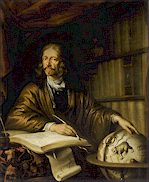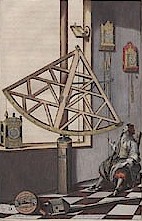|
 Horizontal Table
Clocks
Horizontal Table
Clocks
As the bourgeoisie increased during the renaissance,
so did the demand for smaller horizontal table clocks and neck
watches increase. These clocks were driven by a spring and used a
balance as regulator which enabled them to be transportable. They
originated in Southern Germany, particularly in Augsburg and
Nuremberg. In Holland, clockmakers such as Salomon Coster, Severijn
Oosterwijck and Jan Janse Boekelts were also developing these clocks
in cities such as Haarlem, Amsterdam and The Hague. Examples
originating from Danzig (Pomerania) were, for instance, designed by
Johann Eichstedt, Wolfgang Günther and Johann Anton Horn.

fig. 2.
Horizontal table clock with astronomical signs, signed
Wolffgangus Günter Gedan
(property of the Muzeum Narodowe, Warsaw)
 The development of the pendulum clock
The development of the pendulum clock
During the 17th century, time measurement became increasingly
important in the study of sciences such as astronomy. Astronomers
such as Galileo Galilei, Johann Hevelius en Christiaan Huygens were
involved in the development of a precision clock. Thus, the first
pendulum clocks evolved. This type of clock had a free-hanging
pendulum replacing the former regulator task of the balance and
resulting in a much higher grade of precision, thus enabling minutes
and seconds to be registered.
 Johann
Hevelius (1611-1687)
Johann
Hevelius (1611-1687)
Johann Hevelius was the son of the successful Danziger merchant and
beer brewer, Abraham Hewelke. Hevelius took over his father’s beer
brewery and was also active as councillor. He married Katharina
Rebesche in 1635 and the Dutch Catharina Elisabeth Koopman in 1663;
the latter assisted him with his astronomical observations and,
following his death, published several of his works. Hevelius
started his astronomy studies in 1627 receiving private tuition from
Peter Krüger (1580-1639). He was also taught the crafts of
engraving, lens-grinding and mechanical construction.

fig. 3.
Portrait of Johannes Hevelius by Daniel Schultz (1677)
(Property of the Biblioteka Gdanska Polskiej Akademeii Nauk)
end

fig. 4.
Hevelius in his observatory
(Engraving by Isaak Saal after Andreas Stech, 1673)
Two clocks hang on the rear wall – the right-hand one is fitted with
a pendulum. The clock face shows not only an hour hand but also a
second hand. A clock, somewhat similar to a Hague clock, sits on the
window sill.
In 1630 he
then spent a year studying law at Leiden University, after which he
left for London in 1631; between 1631 and 1634 he sojourned in
Paris, Tours and Avignon. Following his return to Danzig, he built
his first astronomical observatory in 1640 for which he developed
various instruments. Several of these instruments are described and
illustrated in his work “Machina coelestis pars prior…” (1673) and
include an experimental pendulum clock.
 continue
continue


This exhibition is part of Prezent, a cultural collaboration project
of the Province of Noord-Holland and the Voivodship of Pomerania
(Poland), organized by Kunst en Cultuur Noord-Holland and Cultureel
Erfgoed Noord-Holland. The exhibition is accompanied by a free
exhibition brochure. The Polish-German catalogue “Zegary Gdanskie”
(Muzeum Historyczne Miasta Gdanska 2005), describing the Danzig
clock industry, is available in the museum bookshop. |
 Back
to previous section.
Back
to previous section.
 Wolfgang Günther (ca 1610-1659)
Wolfgang Günther (ca 1610-1659)
Hevelius requested the help of the clockmaker, Wolfgang Günther, and
that of an unnamed Swedish royal instrument-maker, to construct his
two prototypes of pendulum clocks. Günther, who came from Elterlein
near Annaberg (Saxony), became a citizen of Danzig in 1637. He
carried out restoration repairs to the sundial on the tower of the
main town-hall between 1647 and 1648. He became an elder of the
smith’s guild in 1654. Together with two assistants, he worked on a
prototype of the pendulum clock and other instruments for Hevelius’s
observatory between 1657 and 1659. Hevelius presented a small
prototype to the Polish king Johan Kasimir during his visit to the
observatory in 1659. That same year, Günther was interred in the
crypt of the St. Erasmus chapel in the St. Mary’s church in Danzig.
The observatory was burned to the ground on September 26th 1679.


fig.5.
Altar clock, signed Wolfgangus Günther, Gedan Annis 1650 / Johann
Albrecht RENNOV (=renovated) Frauenburg. (Property of the Muzeum
Uniwersytetu Jagiellonskiego, Krakow) This unusual altar clock is
fitted with a short, suspended pendulum and a mechanism with locking
plate. As well as the hours and minutes, the lunar phases are also
indicated on the clock face.
 Hevelius and Huygens,
Hevelius and Huygens,

fig. 6.
“Hague clock”, signed by Johan Antonius Horn
(private collection)
Johann Anton Horn (ca. 1654-1720) became a citizen of Danzig in
1681. He was the town clockmaker from 1681 to 1720 at a salary of
100 to 120 florins. As such he carried out various repairs to the
turret clocks of the St. Mary and the St. Catharine churches and
several horizontal table clocks are attributed to Horn.
On September 7th 1656, Hevelius calls his brilliant, younger
colleague, Christiaan Huygens, in a letter as a “jewel to astronomy”
and an “honoured friend”. He also presented the first copy of his
dissertation on observations of the planet Saturn to Huygens.
Huygens possessed almost all of Hevelius’s important publications,
including “Selenographia” (1647), “Mercurius in sole vicus” (1662),
“Prodromus cometicus” (1665), “Cometographia” (1668) and “Machina
Coelestis” (1673), together with a commentary on the latter by the
English inventor, Robert Hooke. Hevelius received visits from the
French astronomer, Ismael Boulliau, the English astronomer, Edmund
Halley, as well as from Huygens’s younger brother, Philips. Similar
to Huygens, Hevelius received international recognition. Thus, he
became a fellow of the English Royal Society of Sciences (1664) and
of the French Académie des Sciences (1666).
Excerpt from: Johannes Hevelius: Machinae Coelestis Heavenly
Machines: Chapter XVII: Concerning clocks (Dantzig, 1673)
NTAt last, the construction of a pendulum
which could move and count of its own accord was accomplished.
In the beginning, it was difficult to get the clockmaker to commence
the work (as he was convinced that it be almost impossible to
construct). However, once I had indicated that I was quite serious
and mentioned my expenses, he commenced the work and was very
happily successful, the result of which work was a clock with no
balance, no spring, no fusee and the accompanying twisted cord or
chain, but with only the pendulum, one weight and but a few
cog-wheels.
The author presented the first pendulum
clock to be made in Danzig to the king of Poland.
During the years that this particular clockmaker lived and worked at
my house, he eventually produced two pendulum clocks of this type.
The larger of the two had only two cog-wheels, the other four and
used only one weight. I humbly presented the smaller of the two to
the illustrious Casimir, king of Poland, who was then visiting
Danzig and honoured my house with a visit. I then immediately
ordered a new, very similar clock, excepting that the pendulum was
slightly altered, and I kept this clock as a keepsake to remind me
of this event.
Huygens, the famous clock designer, was the
first person to publish an illustration of a pendulum clock.
Around this time, whilst the two pendulum clocks were being worked
upon by the clockmaker but which were not completely finished (the
clockmaker had little time available due to his work on the larger
astronomic instruments), the very distinguished and very scholarly
Christiaan Huygens invented similar clocks in 1657. This was also a
very successful enterprise, and, a short time later, in 1658, he
published an illustration of the pendulum clock, to the great
advantage of (scientific) literature and for which I congratulate
him. For, this prestigious invention offers an excellent remedy for
all the ills of clocks built as yet, as well as solving the problems
of inaccuracies which have crept into the escapements as well as the
axles, pins and cog-wheels.
 About the author :
About the author :
 Born 1958 in Delft, Pier van Leeuwen studied as a graphic artist at
the Royal Academy of Visual Arts in The Haghe and later as e
museologist at the Reinwardt Academy in Leyden. From 1989 he worked
with a number of Dutch museums in various capacities including those
of exhibition designer, consultant and curator. Born 1958 in Delft, Pier van Leeuwen studied as a graphic artist at
the Royal Academy of Visual Arts in The Haghe and later as e
museologist at the Reinwardt Academy in Leyden. From 1989 he worked
with a number of Dutch museums in various capacities including those
of exhibition designer, consultant and curator.
In 1997 he became Curator of
The Museum of The
Dutch Clock
in Zaandam, which now exhibits the most complete survey of the
history of the Dutch clock. Pier has several publications to his
name including those on such subjects as Dutch Designer Glass,
Modern Sculpture in Zaanstad and the painter Thijmen Moll of Huizen.
In 2002 Pier started a project for the Boom-Time Foundation in
Utrecht, building a website for a virtual catalogue of Dutch signed
clocks, now on-line since 2004.
More links:
Dutch Gold, Silver and Clock Museum.
National Museum from Musical
Clock to Street Organ.
Museum of the Dutch
clock.
National Museum
of the History of Science.
 |




